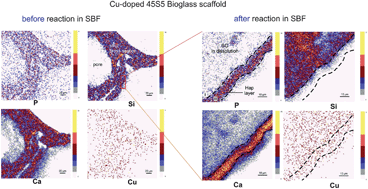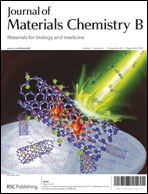In vitro reactivity of Cu doped 45S5 Bioglass® derived scaffolds for bone tissue engineering
Abstract
Cu-doped 45S5 bioactive glasses with varying Cu contents were fabricated and used to process 3D porous scaffolds via the foam replica technique. Cu-doping results in the weakening of the glass network and a decrease in its glass transition temperature. Acellular in vitro studies revealed very high bioactivity independent of Cu doping as indicated by the fast formation of a carbonated hydroxyapatite layer (CHA) on scaffold surfaces after immersion in simulated body fluid (SBF). The kinetics of the glass-ceramic scaffold's transition to an amorphous calcium phosphate layer (ACP) and the crystallisation of CHA were explored by FT-IR and SEM analyses. The elemental distribution in the scaffold/fluid interface region was monitored by the advanced micro-PIXE-RBS (particle induced X-ray emission/Rutherford backscattering spectrometry) method. Cu-containing glasses showed slower release of Si, Ca and P from the scaffold periphery, whereas traces of Cu were found incorporated in the CaP layer on the scaffold surface. Cu release kinetics from the scaffolds in SBF were found to depend on culturing conditions while highest Cu concentrations of ∼3.1 ppm and ∼4.6 ppm under static and quasi-dynamic conditions, respectively, were observed. Since Cu exhibits potential angiogenic and osteogenic properties, the Cu-containing scaffolds are suggested as promising materials for bone tissue engineering applications.


 Please wait while we load your content...
Please wait while we load your content...